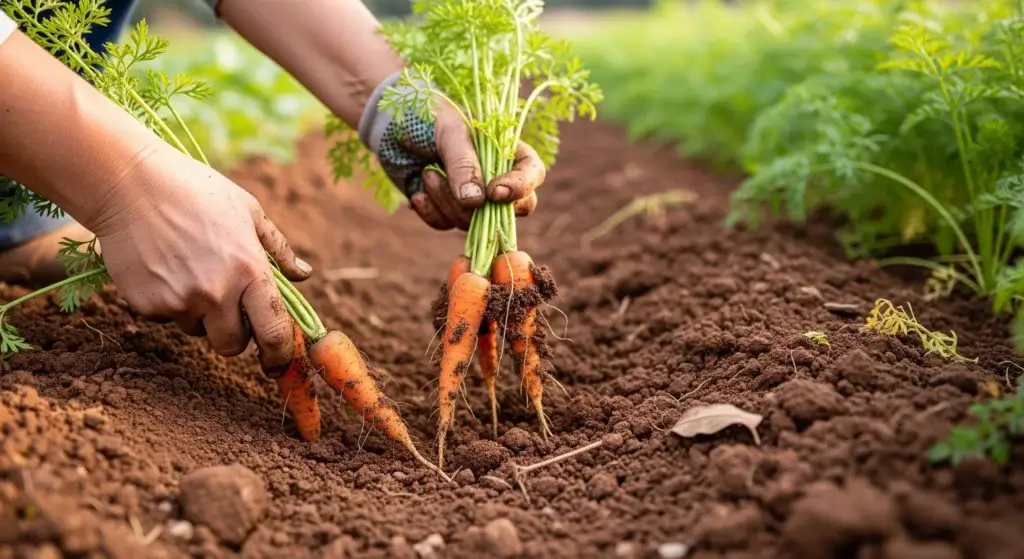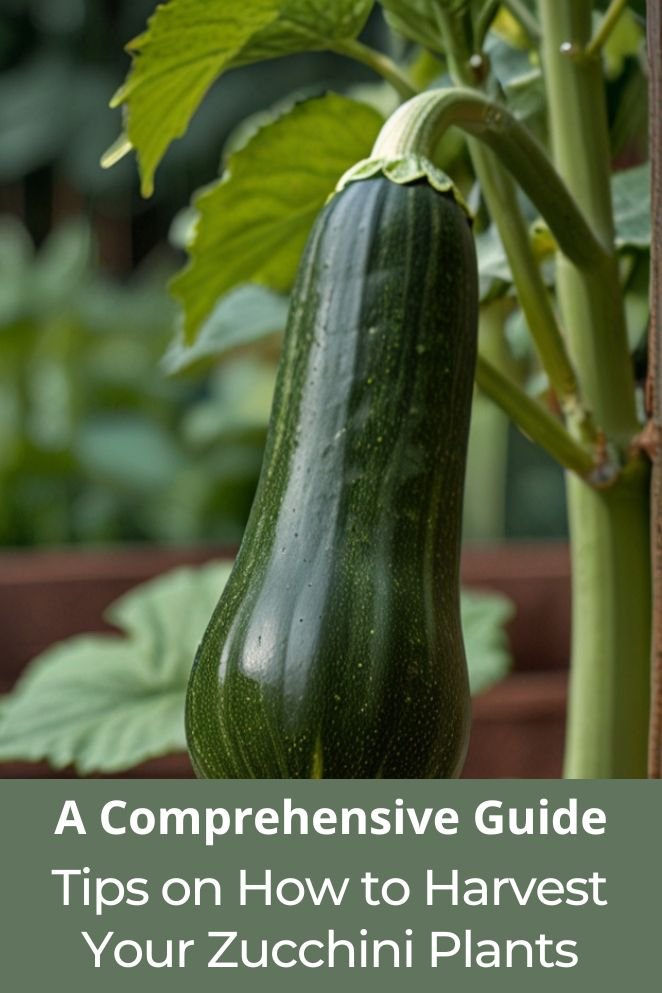
Zucchini, also known as courgette or baby marrow, is a versatile vegetable that can thrive in your garden with minimal effort.
This guide will walk you through everything you need to know about harvesting zucchini, including the best time to harvest, tips for picking zucchini flowers, and how to store your bounty.
When to Harvest Zucchini
One of the most critical aspects of harvesting zucchini is timing. Picking zucchini at the right time ensures they are tender and flavorful.
Here’s a detailed guide to help you pick your zucchinis at their best:
Ideal size
Begin harvesting zucchinis when they are about 6 to 8 inches long.
At this size, they are tender and have a mild, pleasing flavor. The zucchini should be about 1.5 to 2 inches in diameter.
This indicates they are still young and not overly mature.
- Read also: A Comprehensive Guide: Growing Cauliflower in Containers
- Read also: A Guide for Gardeners: How to Maximize cabbage head size
Visual cues
Look for a uniform, deep green color.
Some varieties might be yellow or striped, so know your variety’s ideal color.
The skin should be glossy. A dull or matte appearance can indicate the zucchini is past its prime.
If you’re not sure whether or not your zucchini is ready to harvest, it’s always best to pick it a little bit early.
Zucchini will continue to ripen after it is picked. If you wait too long, the zucchini can become tough, seedy, and less flavorful.
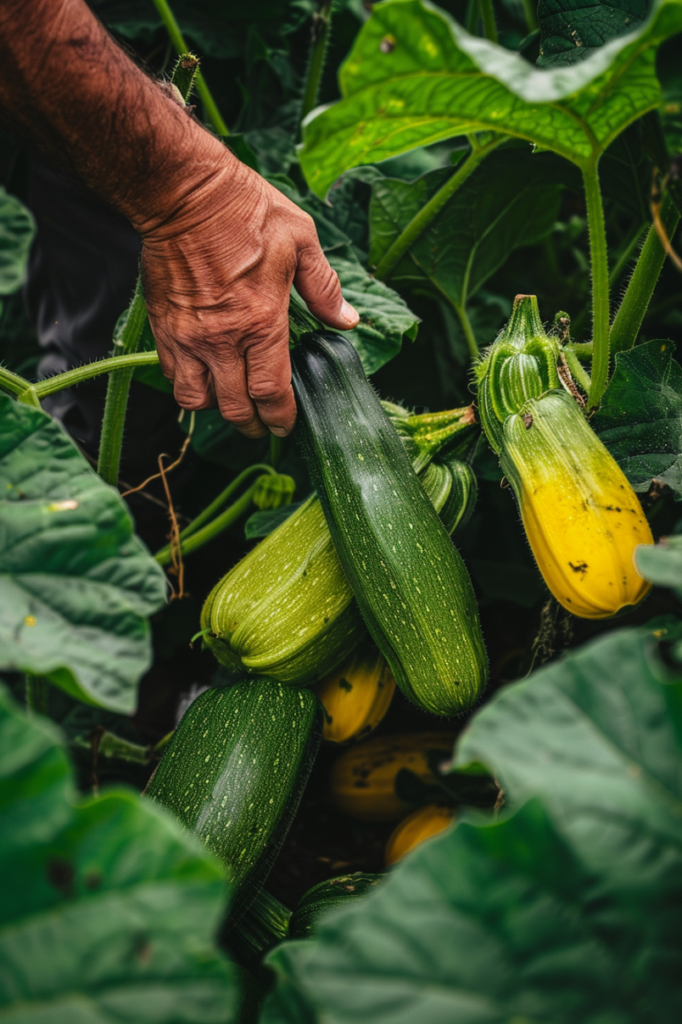
Harvest Zucchini Flowers
Harvesting zucchini flowers is a delightful practice that adds a gourmet touch to your cooking.
Zucchini flowers are edible and can be used in various dishes, from salads to stuffed blossoms.
To harvest zucchini flowers, it’s essential to know the difference between male and female flowers:
- Male flowers: These are the first flowers to appear on the plant. They have a thin stem and do not produce fruit. Male flowers are commonly harvested for cooking.
- Female flowers: These flowers appear later and are attached to the developing zucchini. Harvesting female flowers reduces the fruit yield, so they are less commonly harvested unless there is an abundance of zucchini.
For the best results, harvest male flowers early in the morning when they are fully open.
The flowers tend to close later in the day, making them harder to work with.
Be careful not to take too many male flowers, as they are necessary for pollination.
Female flowers can also be harvested, but doing so will reduce the number of zucchinis your plant produces.
To harvest zucchini flowers, use clean and sharp scissors or garden shears to cut the flowers.
This minimizes damage to the plant.
It’s essential to leave a few male flowers on the plant to ensure the female flowers get pollinated, which is necessary for fruit production.
After harvesting, if you need to store them, place the flowers in a plastic bag with a damp paper towel and store them in the refrigerator.
They should be used within a day or two for optimal freshness.
Excess moisture can cause the flowers to rot quickly, so ensure they are dry before storing.
How Often to Harvest Zucchini
Zucchini should be harvested frequently to ensure the best quality and to encourage continued production.
Ideally, you should harvest zucchini every 1 to 3 days during the peak growing season.
Zucchini can grow very quickly, sometimes even doubling in size in just a couple of days.
Regular harvesting encourages the plant to produce more fruit.
If you leave zucchini to grow too large, the plant will divert energy into maturing seeds rather than producing new fruit.
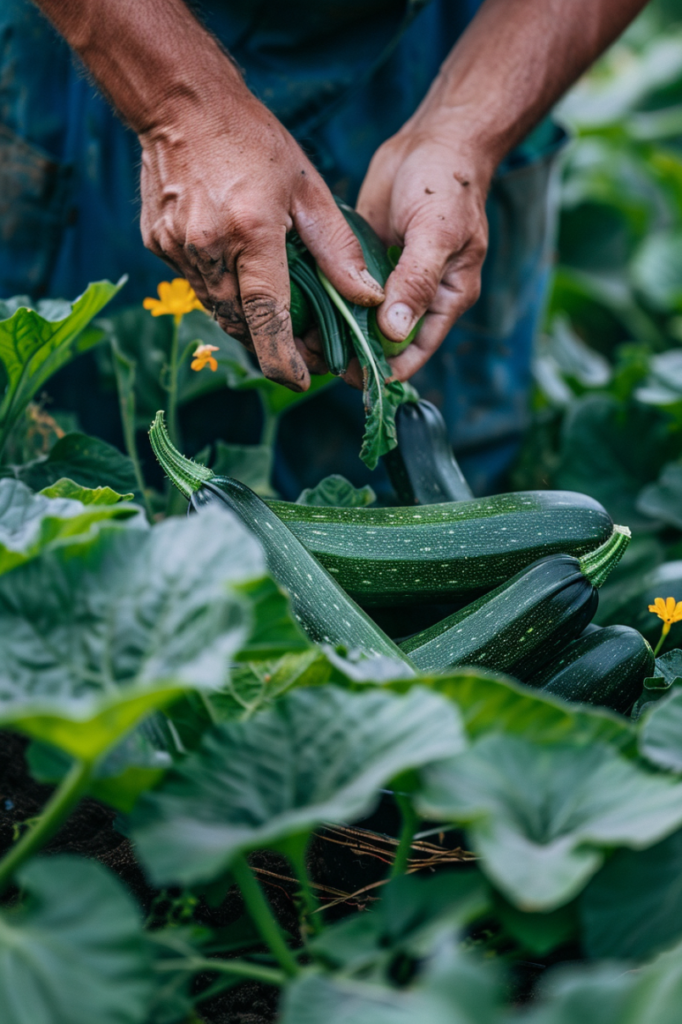
Best Time to Harvest Zucchini
The time of day actually doesn’t significantly impact zucchini harvesting.
Here’s why the time of day is less important for zucchini:
- Wilting: Unlike leafy greens that wilt quickly in hot afternoon sun, zucchini are more resilient.
- Focus on maturity: The best time to harvest zucchini is based on its size, maturity, and how you plan to use it, not the time of day.
Tips for harvesting zucchini:
- Harvest after the dew dries: If you prefer to harvest in the morning, waiting until the dew dries on the zucchini helps prevent the spread of disease.
- Avoid direct sunlight: Regardless of the time of day, keep harvested zucchini out of direct sunlight to maintain freshness.
- Chilling soon after picking: No matter when you harvest, aim to refrigerate your zucchini as soon as possible for optimal storage.
Zucchini Harvest Season
Zucchini is a popular warm-season crop that flourishes in the summer months.
Here are some detailed insights into the zucchini harvest season to help you make the most of your crop:
Planting time
Zucchini should be planted after the danger of frost has passed and the soil has warmed up. This usually means late spring in most regions.
Growth period
Zucchini plants typically start producing fruit 45 to 55 days after planting. This rapid growth makes them a favorite among gardeners who want quick results.
Initial harvest
Depending on your local climate and planting time, early summer is typically the peak harvesting season for zucchini in many regions.
The weather is warm but not scorching hot, and the days are longer, providing ideal conditions for rapid zucchini growth.
Harvest zucchini in late summer as days become shorter and temperatures start to dip, zucchini growth may slow down a bit.
You can still harvest during this time, but the fruits may take a little longer to mature.
The harvest season can last several months, often extending through early fall, as long as the warm weather continues.
Extending the season (with protection)
In some areas with mild fall weather, you may be able to extend your zucchini harvest season by protecting your plants from frost.
You can use row covers or mulch to help retain heat in the soil.
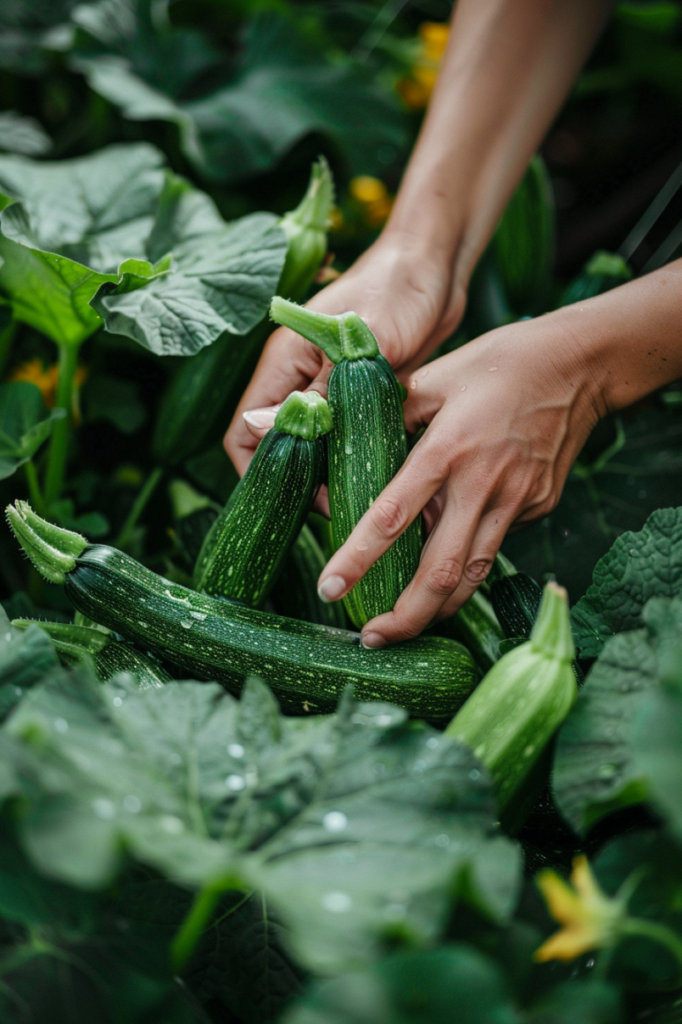
How to Harvest Zucchini
Harvesting zucchini is straightforward, but a few tips can make the process smoother and more productive. Here’s a detailed guide to help you:
Tools for harvesting
There are two main tools you can use to harvest zucchini:
- Sharp knife or pruners: This is the preferred method for clean cuts and minimizing damage to the plant.
- Sharp scissors: Scissors are a good alternative, especially for younger, more tender stems.
Instruction for harvesting
Step 1: Identify ripe zucchini
Look for firm fruits that are 6-8 inches long, with smooth, brightly colored skin (depending on the variety). The blossom end may feel slightly soft when pressed gently.
Step 2: Locate the stem
The stem attaches the zucchini to the vine.
Step 3: Make a clean cut
Using your sharp tool, cut the stem about 1-2 inches away from the zucchini fruit. This leaves a bit of stem on the zucchini which can help it stay fresh longer.
Don’t try to twist or pull the zucchini off the vine. This can damage the plant and potentially break the fruit.
How to Store Harvest Zucchini
Proper storage of zucchini ensures you can enjoy your harvest for weeks to come. Here are some tips for storing zucchini:
For short-term storage (Up to a week)
Freshly harvested zucchini can be stored in the refrigerator for short term storage.
Place them in a plastic bag with some holes to allow for air circulation and prevent moisture buildup.
Don’t wash zucchini, washing can encourage spoilage. Wait to wash until you’re ready to use the zucchini.
For long-term storage (Months)
If you have a zucchini surplus and won’t use them all within a week, consider these methods for longer storage:
- Freezing: If you have an abundance of zucchini, consider freezing them. Wash and slice the zucchini, blanch in boiling water for a couple of minutes, then cool quickly in ice water. Drain and pack the slices into freezer bags, removing as much air as possible.
- Drying: Zucchini can also be dried and stored. Slice thinly and place in a dehydrator or a low oven until fully dried. Store in airtight containers in a cool, dark place.
- Canning: Another option for preserving zucchini is canning. Follow safe canning practices to ensure your zucchini is preserved correctly and safely.
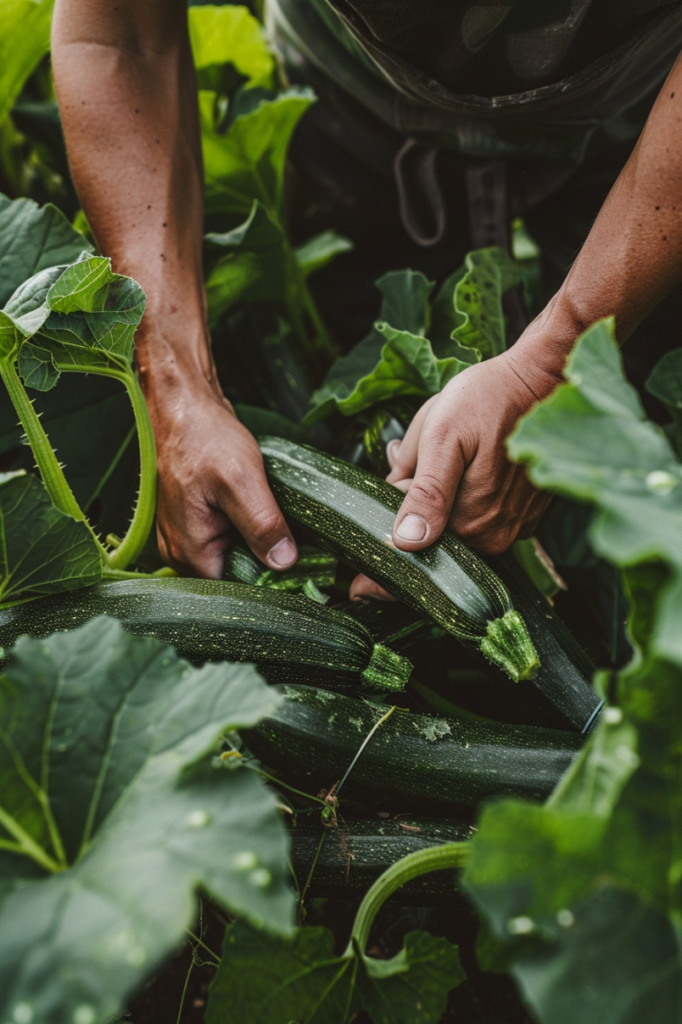
- Read also: Broccoli Bonanza: Unveiling the Best Time to Plant Broccoli
- Read also: Extend Your Harvest: Tips for Growing Broccoli in Winter
Conclusion
Harvesting zucchini at the right time with a proper technique and storing it properly will provide you with a continuous supply of fresh and delicious vegetables.
Regularly check your plants, and harvest zucchinis when they are young and tender. With these tips, you’ll be well on your way to making the most of your zucchini harvest.
FAQs
During peak growing season, you should check your zucchini plants daily. Zucchinis can grow very quickly, and harvesting regularly will ensure you pick them at their best.
Yes, but large zucchinis can be tough and less flavorful. They are best used in recipes where they can be grated, such as zucchini bread or fritters.
If your zucchini plant stops producing, it could be due to a lack of pollination or nutrients. Ensure your plants are getting enough water and fertilize if necessary. You can also hand-pollinate by transferring pollen from male to female flowers with a small brush.
It is normal for male zucchini flowers to fall off after they have released their pollen. If female flowers are falling off without producing fruit, it might be due to poor pollination. Ensure your garden is friendly to pollinators like bees, or consider hand-pollinating.

